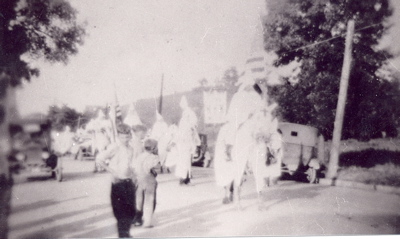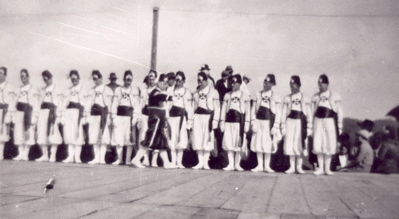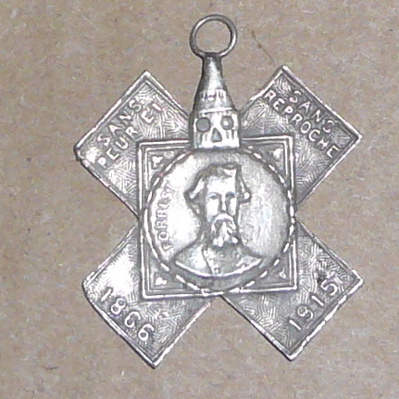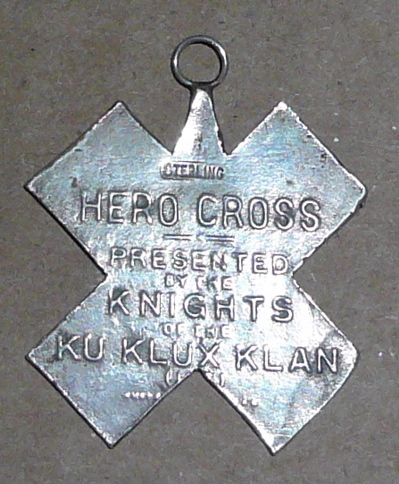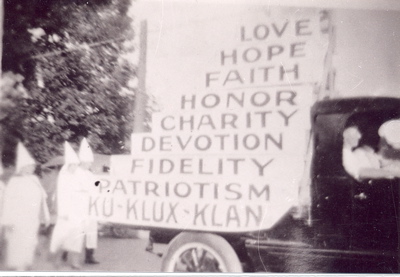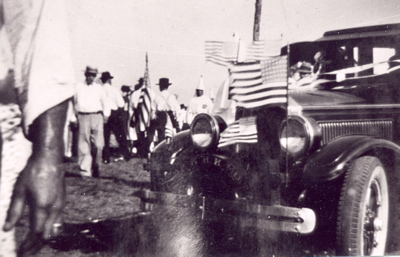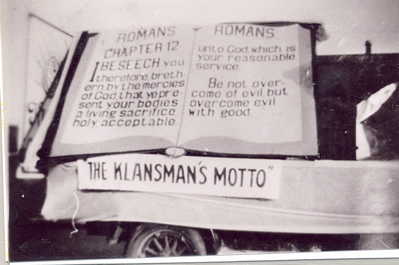Encyclopedia Dubuque
"Encyclopedia Dubuque is the online authority for all things Dubuque, written by the people who know the city best.”
Marshall Cohen—researcher and producer, CNN
Affiliated with the Local History Network of the State Historical Society of Iowa, and the Iowa Museum Association.
KU KLUX KLAN: Difference between revisions
No edit summary |
No edit summary |
||
| Line 3: | Line 3: | ||
[[Image:parade.jpg|left|thumb|250px|Members parade near Dubuque during a konklave circa 1920. Photo courtesy: Bob Reding.]] | [[Image:parade.jpg|left|thumb|250px|Members parade near Dubuque during a konklave circa 1920. Photo courtesy: Bob Reding.]] | ||
[[Image:leaders.jpg|right|thumb|250px|Local members of the KKK during a konklave. Photo courtesy: Bob Reding]] | [[Image:leaders.jpg|right|thumb|250px|Local members of the KKK during a konklave. Photo courtesy: Bob Reding]] | ||
Revision as of 02:37, 14 October 2013
This entry is being edited.
KU KLUX KLAN. Known by its initials, K.K.K., the Klan was originally a southern white supremacist organization. It was developed during Reconstruction following the CIVIL WAR to prevent AFRICAN AMERICANS from pursuing civil rights granted ex-slaves in federal legislation. The passage of the Ku Klux Klan Act of 1871 led to a decline in the movement until after WORLD WAR I when it was revived as anti-Catholic, anti-Semitic, anti-African American, anti-foreign, and anti-organized labor.
With the rebirth of the movement came the familiar secrecy and white cloaks. Members attended "konklaves" and sang "klodes." Limited in membership to white Protestant men, the organization's membership peaked nationally in 1925 with an estimated five million members.
Dubuqueland chapters of the Klan varied from extreme patriotic clubs to fervently anti-Catholic groups.
The first burning of a cross was seen on December 4, 1925, by residents of the north end. Within the next year and one-half, two additional crosses were burned in the city.
Reaction to the Klan included an attempt in April 1924, to break up a meeting. Several anti-Klan participants were arrested and three were injured. In the same year on August 10th, "Tolerance," a Chicago newspaper published the names of Dubuque residents it believed were members of the Dubuque Klan. In response, eight of the men named took out an advertisement in the Telegraph Herald, denying their Klan membership and offering a $5,000 reward to the Chicago paper or anyone who could produce evidence to substantiate the charges or even that any of them had attend a Klan meeting. (1)
A cross was not confined to protest. In August 1926 the women of the Dubuque Klan held a business meeting on Klan property along Peru Road. As part of the meeting a large cross would be illuminated from where it stood on a 40 foot high platform. The sight was said to be be visible from Sageville Road. (2)
A "Konklave," held in 1926 on an eighty-acre "klavern" on Peru Road, was said to have attracted thousands who paid admission. The event included a parade described in the newspaper as to be "one of the most impressive ever staged in the history of the city." Beginning on Peru Road, the path went to West 32nd and down Jackson to 16th Street, west on 16th to Central, south to Fourth and then west to Main. Continuing north on Main to 17th Street, east to Central, north to 24th and then Jackson for the return to Peru Road. An estimated 30,000 to 50,000 Klan members from Iowa, Illinois and Wisconsin were expected to attend. (3)
In 1926 the Klan successfully petitioned the city council for a parade permit. Klan members from Elkader and Maquoketa attended along with the Charles City "Kitchen Kanaries," a musical group. Local participation in the festivities included the Dubuque Ladies Klan Drill Team. Movies of this event were shown on the "Klan Field" along Peru Road following a musical performance of the Klan band. (4)
In 1927 Dubuque County Klan No. 20 as well as the ladies of the Ku Klux Klan announced a picnic for August 27th to be held in Stewart's Grove, west of Dubuque on the Millville Road. The public was invited. This event was chosen rather than the large konklaves that had been held the previous two years. A minister from Chicago was scheduled to give a patriotic and inspirational speech. Several local ministers were also planned to speak to the group. Other entertainment was planned from the Dubuque County Klan ladies drill team which won all prizes for the past two years in state contests. The newly organized Klan ladies drum corps would give their initial performance. Games were provided for the children as well as ball games and horseshoe pitching. (5)
By 1927 membership in the Klan had begun to decline although some merchants continued to encourage business with the sign "TWK" (Trade with Klansmen) in their windows.
The flaming cross again appeared in Dubuque on October 23,1989, when a charred cross inscribed with "KKK lives" was found in the burned remains of a garage belonging to an officer of the Dubuque NATIONAL ASSOCIATION FOR THE ADVANCEMENT OF COLORED PEOPLE (N.A.A.C.P.).
Because of the cross-burning incident, the city council in May 1990 adopted an plan to attract 100 black families in hopes of adding diversity to the city of 58,000 people. A backlash of fear and intolerance has erupted. Five crosses were burned around town between September and November. During the first week of November, uniformed police officers stood guard at DUBUQUE SENIOR HIGH SCHOOL after racial fights broke out. Racial epithets were scrawled on buildings across town, some proclaiming "the New KKK." (6)
On November 30, 1991 an estimated two hundred people attended a rally with Thomas Robb, a national leader of the KKK, following ten cross burnings in the city. The local chapter of the National Association of Colored People (NAACP) held a counter rally to protest the cross-burnings and Robb's visit. (7)
---
Source:
1. "$5,000 Reward to the Public" (personal advertisement), Telegraph Herald, Aug. 8, 1924, p. 4. Online: http://news.google.com/newspapers?id=djFFAAAAIBAJ&sjid=hbsMAAAAIBAJ&pg=4849,712611&dq=kkk+dubuque&hl=en
2. "Klan Women Plan Meeting Tonight," Telegraph Herald, August 31, 1926, p. 8. Online: http://news.google.com/newspapers?id=4jRFAAAAIBAJ&sjid=krsMAAAAIBAJ&pg=3071,379826&dq=kkk+dubuque&hl=en
3. "Knights of Klan Coming Saturday," Telegraph Herald, Aug. 27, 1926, p. 2. Online: http://news.google.com/newspapers?id=0TJFAAAAIBAJ&sjid=j7sMAAAAIBAJ&pg=3605,6850377&dq=kkk+dubuque&hl=en
4. "Klan Parades Shown in Movies," Telegraph Herald, Sept. 19, 1926, p. 11. Online: http://news.google.com/newspapers?id=8jRFAAAAIBAJ&sjid=krsMAAAAIBAJ&pg=6802,2710721&dq=kkk+dubuque&hl=en
5. "Klan Picnic to be Held Saturday," Telegraph Herald and Times Journal, Aug. 21, 1927, P. 7. Online: http://news.google.com/newspapers?id=B5BFAAAAIBAJ&sjid=1bwMAAAAIBAJ&pg=6080,474093&dq=kkk+dubuque&hl=en
6. Wilkerson, Isabel. "Seeking a Racial Mix, Dubuque Finds Tension," New York Times, Nov. 3, 1991. Online: http://www.nytimes.com/1991/11/03/us/seeking-a-racial-mix-dubuque-finds-tension.html
7. "Klan Leader Attracts 200 in Dubuque," Akron Beacon Journal, Dec. 1, 1991. Online: http://nl.newsbank.com/nl-search/we/Archives?p_product=AK&s_site=ohio&p_multi=AK&p_theme=realcities&p_action=search&p_maxdocs=200&p_topdoc=1&p_text_direct-0=0EB62D7930A248B6&p_field_direct-0=document_id&p_perpage=10&p_sort=YMD_date:D&s_trackval=GooglePM


